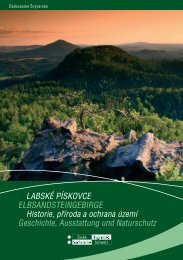ABSTRACT BOOK Sandstone Landscapes ... - Sandstones.org
ABSTRACT BOOK Sandstone Landscapes ... - Sandstones.org
ABSTRACT BOOK Sandstone Landscapes ... - Sandstones.org
Create successful ePaper yourself
Turn your PDF publications into a flip-book with our unique Google optimized e-Paper software.
PJana Soukupová 1 and David Hradil 21 Institute of Rock Structure and Mechanics, Academy of Sciences of the Czech Republic, V Holešovičkách41, CZ-182 09 Prague 8, Czech Republic (finy@seznam.cz)2 Institute of In<strong>org</strong>anic Chemistry, Academy of Sciences of the Czech Republic, CZ-250 68 Řež, CzechRepublic (hradil@iic.cas.cz)Salt weathering of Cretaceous sandstones in acidified areas: predictions and realityFormation of salt crusts on sandstones is common in conditions of chemical weathering. The diagnosis ofthe salt source and process of its formation is complicated in nature and related to physical-chemicalconditions of the system in the contact with water and atmosphere. At first, the thermodynamic factorsshould be taken into account. In our study, we have used typical composition of the acid rainwater collectedin polluted regions of N and NW Bohemia (data of Czech Hydrometeorological Institute) to calculate thesaturation indexes using MINEQL and PHREEQC software, alternatively. We have found that gypsum istheoretically the most perspective secondary phase. The results of direct evaporation tests showed thatgypsum usually occurs as main crystalline mineral in the precipitate. Gypsum is usually present in crustseven on calcium-depleted sandstones with clay matrix; the support of calcium from the rainwater issufficient.As we have found earlier, the mineralogical composition of the crusts on Cretaceous quartz sandstone of Nand NW Bohemia is quite similar in all studied samples; gypsum and ammonium and/or potassium-richalums are predominant phases in most of samples. Except of aluminium, occurrence of all the maincompounds forming the crusts (SO 4 2- , Ca 2+ , NH 4 + ) is in good correlation with a typical composition of acidrain; while evaporating, gypsum is preferentially crystallized; ammonium alums are preferentiallycontaminated by potassium. The low pH values of penetrating solutions cause the dissolution ofaluminium-bearing minerals and these conditions are suitable for the rise of Al-SO 4 minerals as typicalproducts of acid-sulphate alterations. The problem is that thermodynamically the most perspective phase –alunite – frequently mentioned in the literature, has not been found in any of about 200 samples ofsandstone weathering crusts. Instead of that fairly soluble alums usually appear. It clearly demonstrates theimportance of kinetic factors of mineral precipitation and dynamic effects of water movement within theporous media (wetting/drying alterations), which probably significantly affect the relative stability of thesemineral forms during the chemical weathering.




